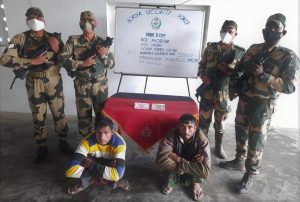Networks for the supply and distribution of fake Indian currency notes (FICN) appear to have proliferated in Bangladesh over the past year, the culmination of a long sequence of developments originating more than two decades ago.
While some cities in Bangladesh were long-known to be hubs of the counterfeit currency racket, the recent spurt in the illicit import of FICN into India through the border was a cause of concern that has also set alarm bells ringing in several departments of the Indian government, an investigating official told The Diplomat.
On February 9, police in Dhaka seized a large number of gunny bags filled with a colossal quantity of FICN and arrested some people suspected to have been involved in the racket. An official told the media that it was the largest ever consignment of fake Indian currency to have been confiscated in Bangladesh.
Last year in November, police officials were quoted by the media in Dhaka as saying that a Lahore-based syndicate in Pakistan prints FICN, which are then transported to Bangladesh via Sri Lanka in containers loaded with marble stones. The consignments are hidden in “special chambers” at the homes of syndicate members before being smuggled into India.
The FICN boom in Bangladesh was unearthed months earlier following a probe by an Indian security agency, resulting in the compilation of a report with extensive details of the centers and people involved in the supply of the fake currency notes from Bangladesh to India.
The investigation confirmed the continuation of the phenomenon that began decades ago: FICN are printed in Pakistan and then illicitly imported into India either directly through the border with Nepal and Bangladesh or through other routes linking Dubai, Bangkok, Hong Kong, and Colombo.
The investigation revealed that FICN are also being printed in denominations of (Indian) Rs 2,000 ($27), Rs 500, and Rs 200 in and around the vegetable wholesale market area of Kalyanpur in Dhaka. These notes are ferried to the border at Kurigram and exported to India in small quantities through multiple routes in Assam and West Bengal. Sometimes, packets of currency are smuggled by women and also thrown over the border fence at night. These are collected by accomplices on the Indian side.
Among the kingpins whose names surfaced during the probe were Milan Sheikh and Umar Ali both of Rangpur in Bangladesh who are employees of a transport company named Suchana Transport in Kurigram. The main distributors of FICN are Mohammad Rafiqul Islam, Mukul Sheikh, Asraf Ali, and Milan Sheikh. All of them operate from the border districts of Rangpur and Kurigram.
The kingpins in the Indian border district of Dhubri in Assam were identified as Ashraf Ali, Abdul Gafur, and Jahangir Alom from another border district, South Salmara. The name of a functionary of a prominent political party in Assam also figures in the report as being one of the beneficiaries of the smuggling of FICN.
In Dhubri, seizure of consignments by the Border Security Force and arrests of agents engaged in the smuggling are not an uncommon phenomenon.
“Four cases have been registered in Dhubri over the past seven months. It appears that there are many gangs that operate in the Indian border districts who are not organized and they receive small consignments which are either thrown over the fence or imported through other ways,” Dhubri Superintendent of Police Abhijit Gurav told The Diplomat.
Officials who conducted the probe were of the firm view that it is the printing of FICN at several government printing presses in Karachi, Multan, Quetta, Lahore, and Peshawar in Pakistan that is the main reason for the abundance of Indian counterfeit currency in Bangladesh. Their probe has also found that officials at the Pakistan High Commission in Dhaka have been tasked to supervise the smuggling of the counterfeit currencies to India.
These developments are an indication of the Bangladesh government’s failure to curb the proliferation of Indian counterfeit currency, despite signing a memorandum of understanding with the Indian government to counter the menace.
Over the past several years, many institutions have been drawing attention to the threat posed by fake currency to the Indian economy. The matter received international attention in 2011 when the International Narcotics Control Strategy Report of the U.S. State Department confirmed that an increasing inflow of counterfeit currency produced in Pakistan was being smuggled to India and that terrorist and criminal networks used this money to finance their activities in the country.
In 2015, another study by the Indian Statistical Institute mentioned that counterfeit currency worth Rs 4 billion was in circulation in India at any given time with Rs 7 million entering the system every year.
The findings of the Indian Statistical Institute seem to be at variance with the estimates of other Indian government departments. The government told Parliament in 2014 that there are no reliable estimate of fake currency available. Indian security agencies are of the view that the quantum of FICN in circulation in the country has steadily increased over the years which could be several times more than the estimate arrived at by the Indian Statistical Institute.

































